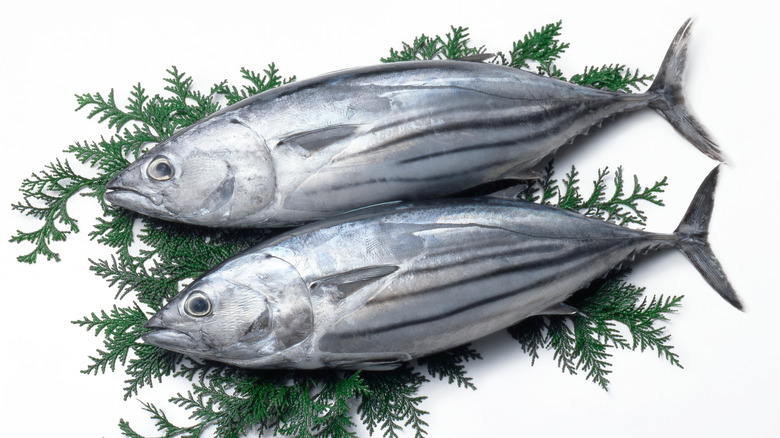The Reason You Should Think Twice Before Eating Tuna Skin
Fish is a major protein source across the globe, with scores of people nourishing their bodies with a variety of different fish every day. As with chicken, when preparing fish, it's important to consider whether you're going to cook it boneless and skinless. Provided the scales are removed, fish skin is generally safe to consume, and doing so comes with numerous health benefits, including a boost of heart-healthy omega-3 fatty acids and Vitamin D (via Healthline). In the interest of reducing food waste, chefs like Nyesha Arrington are even advocating for finding ways to use fish skin in your cooking — she turns salmon skin into a crispy chip for a sustainable snack.
However, like fish meat itself, not all fish skin is created equal; what works for one species might leave a bad taste in your mouth with a different variety. So what about one of the most popular fish consumed in the United States — tuna? This highly nutritious fish comes in many varieties and makes for amazing meals, from seared ahi tuna to a classic tuna melt, and it's even enjoyed raw in sashimi. But if you're thinking about trying its skin in an effort to reduce food waste, you might want to reconsider.
Leathery tuna skin is better put to other uses
Unfortunately, while you might enjoy a crispy and flavorful seabass skin, tuna won't be so kind to your tastebuds — its skin is simply too leathery to enjoy. But while it's often thrown out, contributing to food waste around the globe, not all hope is lost when it comes to finding a use for the inedible skin.
Because tuna skin is so leathery, clever engineering has discovered that it can be recycled. In Japan, manufacturers have figured out how to convert discarded bluefin tuna skin into leather suitable for making wallets, business card holders, and more. Additionally, collagen protein can be extracted from the tuna skin in order to be turned into beauty products or even candies. The marine leather trend is also extending outside of tuna to combat fish waste on a larger scale — another manufacturer in France, Ictyos, claims to have already saved 20 tons of fish skin from filling up landfills (and releasing methane gas into the environment) by using the skins in their own leather products, including purses and watch bands.
So while eating tuna skin isn't a great idea — unless you've managed to acquire a taste for its very leathery texture — it's good to know that with a little creativity, it can still go much further than the landfill.

